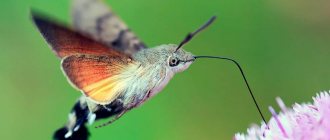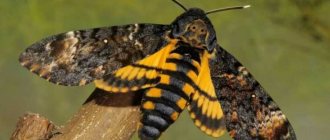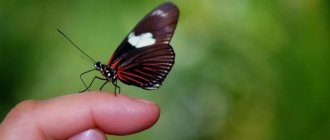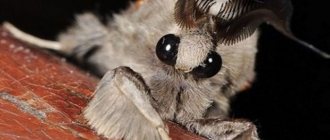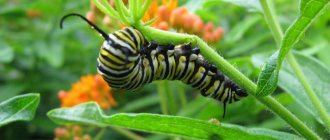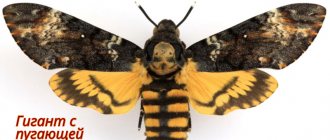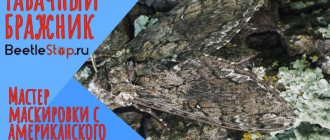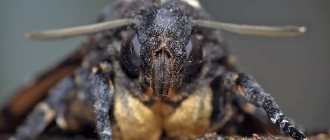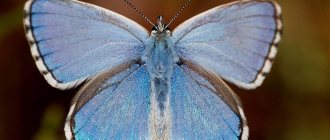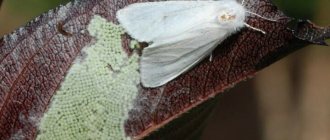A moth is an insect belonging to a species characterized by a wealth of species diversity. They are distinguished by the fact that they lead an active life mainly at night or at dusk. These insects differ from daytime insects in structure, having a longer body, and coloring - which is not as bright and colorful as those of sunlight lovers.
Appearance and structure of butterflies
Moths are called moths with different antennae, which is associated with the anatomical structure of the antennae, which look like feathers or threads.
What does a moth look like? Its body, like that of other species of this order of insects, has three sections, abdomen, sternum and head . The latter of butterflies does not differ in size; it is decorated with eyes and large antennae. There are 2 pairs of wings on the insect's chest, and its body is covered with tiny scales and hairs.
The oral apparatus has some features:
- the proboscis, with the help of which the insect takes food, is presented in the form of a flat spiral that folds and unfolds and opens directly into the larynx;
- when the proboscis is not required, it is twisted and hidden under the scales covering the butterfly's head;
- when expanded, the proboscis is ideally suited for absorbing liquids;
- adult individuals have jaws (similar ones can be seen in caterpillars and other types of insects), allowing them to chew through the necessary objects.
As for the wings, they practically do not differ from those found on daytime individuals. Night beauties have 2 pairs of wings, which are quite densely dotted with tiny hairs, as well as scales that form clusters of hairs.
The structure of the wings may differ among different subspecies:
- a butterfly may not have wings at all (this structure is passed on by insects from generation to generation and is an evolutionary manifestation);
- have a wide wing surface;
- have very narrow wings, almost linear.
The flight that a butterfly can demonstrate depends on the structure of its wings. For example, male mothfish are excellent flyers who dive superbly in the night sky. And their females can be either with or without wings.
On the other hand, there are known species of moths that have wings of a standard size and shape that do not allow the insect to fly (for example, the silkworm). The best developed flying apparatus is in the nocturnal moth - the hawkmoth subspecies, whose narrow wings have a high flapping frequency, allowing them to fly quickly and hover in the air for a while, as hummingbirds do.
Some subspecies of moths (the same hawk moth, glass moth) have no scales or hairs at all on the surface of their wings. However, this fact does not in any way affect their ability to fly; the narrowness of the wings allows them to stay stably in the air.
Small individuals have rather narrow wings, which keep them in the air only due to the thick scales located on the sides.
The main difference between diurnal and nocturnal butterfly species is the mechanism for attaching the rear and front pairs of wings:
- Bridle : in this case, a small process extends from the hind wings, which is inserted into a segment of the front wing. In males it is located on the lower part of the forewing, in females it is at the base of the medial vein; it is a cluster of villi.
- Jugum : on the forewing there is a small blade, which is fixed at its base. It is she who fastens both wings to each other.
The hawk moth is also active at night
Reproduction process
Butterflies have the ability to find mates over long distances. The male can sense the female at a distance of several kilometers. This is explained by the fact that the female produces specific substances that the male is able to catch with his antennae. Some females have the ability to produce an ultrasonic signal, which can also be sensed by males at great distances.
In the reproduction of butterflies, an important role is played by the shape and color of the wings, as well as complex forms of courtship - dancing and mating flights. Some species exhibit sexual dimorphism. It is important for a normal sexual cycle, since it is easy to determine a marriage partner based on external differences. In addition, pheromones secreted by insects make it easier to find a partner.
Mating itself takes place on the ground or the surface of a plant. Its duration can vary - from 15 minutes to 1-2 hours. During mating, individuals are motionless. In addition to sperm, the female receives from the male some trace elements and proteins that are necessary for the formation of eggs.
The sense organs of butterflies are presented as follows:
- Olfactory organs : in a moth they are outgrowths shaped like a cone or a wedge. Around them there are a number of sensory cells that lie in the deep layers of the skin and connect to the nerves responsible for sensory functions. Butterflies' sense of smell is quite acute, and it is thanks to it that they find males, females or food.
- Hearing organs : some individuals are distinguished by the presence of tympanic organs, which are absent in diurnal moths. Receptors of this type are located on the abdomen or back of the sternum, in special lateral recesses, which are covered with a cuticular membrane (underneath there is a trachea). Sound waves that travel through the air cause the membrane to vibrate, causing cells to be excited and information to be transmitted through sensors.
- Organs of vision : moths have two faceted eyes that occupy the main surface of the head. These organs of vision have the same structure as those of other insects: they consist of many small elements, including the lens, retina and innervation. As a rule, moths see much better up close than at a distance. The organs of vision of moths are designed, first of all, to detect oncoming movement and move in space themselves.
The eyes of butterflies are designed in such a way that they perceive all information separately. Therefore, the insect receives a mosaic image as output, which enlarges the real image of the object several times.
Eye structure
general information
The scoop, what is it, is a butterfly - a moth from a very large family, which consists of 15 subfamilies and over 35 thousand species. Night owls belong to the even larger order Lepidoptera , which is represented by a huge number of moths, butterflies and moths.
Cutworm pests are considered the most dangerous and malicious insect of various cultures , despite their absolutely harmless appearance.
Features of color
Having seen the flourishing of these insects, many wonder whether moths are dangerous. In fact, they are no more dangerous than the daytime varieties, but the pigmentation of the moths deserves attention.
The color of butterfly wings has a dual nature: structural and pigment . This means that the scales that are located on the surface of the insects’ body contain pigment. It is this substance that absorbs the sun's rays or simply daylight and reflects them, due to which the solar spectrum of shades visible to the human eye appears. As for the structural part of the color, it appears as a result of the refraction of the sun's rays, which does not require the presence of pigment.
Important! Moths have predominantly pigmented coloration.
Pea cutworm
These pests cause damage to legumes and grain crops. They live in many areas. Pea cutworms parasitize peas, alfalfa, clover, sugar beets and legumes.
Some cutworms feed on animal blood.
The butterfly measures no more than 42 millimeters. The front wings are black-brown in color. There are transverse lines on the wings. The caterpillars are yellow in color, the body size of the caterpillars reaches 4 millimeters.
Flight of pea cutworms takes place in June-September. These butterflies feed on succulent plants. One female lays up to 400 eggs. Caterpillars eat leaves. 2 generations develop per year.
Ways to protect yourself from enemies
The moths of Russia, and all others, are created by nature in such a way as to have protection from ill-wishers.
A list of defense mechanisms of moths is presented below.
Construction of shelters : different subspecies of moths organize similar protective structures for themselves. For example, caseworms and bagworms. The caterpillars of these moths, some time after hatching, build houses around which they attach pieces of foliage and various debris.
These shelters are designed in a special way so that the larva protrudes from them just enough so that in case of danger it can quickly hide inside . The house grows with its owner, at least until she grows up and becomes a pupa (this size is approximately 4-5 cm). After the allotted time, the butterflies come out, but only if we are talking about males. The females stay in these houses longer, until they are fertilized by the male and lay eggs.
Defensive body structures , including hairs and glands, are also defense mechanisms for moths. Do moths bite, having such a formidable weapon? The answer is obvious: only if necessary.
Many caterpillars have a series of bristles or hairs that can burn with poison hidden in the skin glands. During an attack, a dangerous mixture is sprayed from the tip of the bristles, which irritates the skin of the enemy.
In addition, insects use the following means of protection:
- glands in the larvae, with the help of which they cover their own bodies with a liquid that repels approaching predators;
- individual individuals begin to actively move when the enemy approaches, or pretend to be dead, or curl up into a tight ball;
- the larvae, at the moment of approaching danger, can fall from the branches on which they live, hanging on thin silk threads (the individual returns back along the same thread, slowly moving along it with its legs located on the chest and oral appendages);
- hawk moths have dorsal growths that look like horns, which they point towards approaching danger;
- insects can defend themselves with the help of long, prickly hairs covering their body.
The pupae of moths, so helpless in appearance, also have mechanisms to protect themselves from a sudden enemy attack:
- pupae living in the soil are colored in colors that make them invisible;
- moths weave silk cocoons (in the silkworm, such shelters can have up to three layers - loose, dense and filmy), in which they hide from attacks by predators.
Oral apparatus.
Also on topic:
DAY BUTTERFLIES
The proboscis of butterflies, which folds into a flat spiral, is considered the most specialized oral apparatus in the class of insects. When not in use, it is usually hidden under thick scales. The expanded proboscis is well adapted for sucking up liquid food and its base opens directly into the pharynx. Non-feeding adults with rudiments of the oral apparatus are rare among butterflies. The most primitive representatives of this order in adulthood are armed with gnawing jaws, which are also characteristic of caterpillars of other groups of insects.
Coloring to protect against predators
The protective pigmentation of moths has two types of colors:
- Patronizing (cryptic) - helps butterflies to merge with the surrounding space. For example, a moth can completely blend in with the needles on a spruce tree or the leaves on a tree. Other subspecies may have the appearance of tree knots, freezing on a branch at the moment of danger, pretending to be the smallest branches (this is what moths and ribbon moths do).
- Warning (repellent) - in itself attracts the attention of predators, but draws their attention to the fact that the individual has protective means in its arsenal (unpleasant taste, caustic secretion of the glands, the presence of burning hairs on the surface).
The ability of moths to camouflage themselves when danger approaches is admirable. Some blend in with granite rocks, others take on the appearance of bird droppings, and others take on the appearance of bark, flowers or foliage.
Ribbon flies are distinguished by their color, which is visible during flight on their outstretched hind wings. However, this species is completely invisible at rest, if the butterfly folds its wings, the pattern on its back resembles foliage or tree bark.
The wings of night beauties are often decorated with a pattern in the form of wide open eyes. This helps keep predators at a distance.
Eye pattern on wings
Sage cutworm
These butterflies are pests of essential oil crops. Sage cutworms are found wherever there is sage, lavender, mint, and other similar crops.
The wingspan of the butterfly reaches 40 millimeters. The front wings are yellow-gray, the hind wings are lighter.
The flight of these butterflies takes place in April-July. The fertility of females is up to 600 eggs. Caterpillars damage leaves, ovaries, buds and pedicels. They begin to damage plants from top to bottom. 3 generations develop in a year.
Industrial melanism
Industrial melanism is the presence in the body of moths of a pigment that makes them darker than other individuals. This ability is inherited.
Currently, there is a tendency towards an increase in individuals of the melanized species, especially for populations living in Europe. If previously the light color of the night moth was the species norm, today dark moths are replacing them. Despite the fact that the survival rate in nature is higher in light-colored moths, dark ones are better adapted to life with nutritional deficiencies. However, constant clashes with predators leave melanists in the minority.
In areas with industrial production, where many objects of the plant world are covered with soot, melanistic butterflies survive better than their white counterparts, because their camouflage abilities are higher . In addition, they feed on food that is contaminated with industrial waste and this does not in any way affect their life activity, unlike light-colored moths.
What do moths eat in the wild?
There are many varieties of lepidoptera, the adults of which do not eat at all. Their vital activity is supported by nutrients that were accumulated at the caterpillar stage.
Other moths feed on:
- nectar;
- overripe fruits;
- plant juice;
- honey.
Rare species consume the tears and blood of certain animals, as well as their excrement and sweat.
If you breed moths at home, you can prepare a nectar substitute. It can be any sweet liquid. The easiest way is to dilute a little sugar, honey or jam in water. Ripe juicy fruits are also suitable.
Life cycle
How long do moths live? The life cycle of these insects deserves close study; it can be divided into several successive stages:
- Eggs are laid by these moths either in the form of heaps or individual specimens. Moreover, females are able to lay them directly during flight, place them on objects or in vegetation tissues.
- After the allotted time, caterpillars emerge from the eggs, having a head, three pairs of legs with marigolds on the chest, and five pairs of legs on the body. After surviving periods of molting, the caterpillars are enclosed in a cocoon called a pupa. In it, the individual cannot move; the paws are tightly pressed to the body.
- After a while, an adult moth emerges from the pupa.
Yellow-brown early armyworm
This type of cutworm is especially harmful to fruit crops. Early cutworms live almost throughout the entire territory of Russia. Pests damage raspberries, apple trees, cherries, pears, plums, peach and various forest species.
Butterflies reach 35 millimeters in length. The color of the front wings is yellowish with a white stripe, the hind wings have a fringe. The body length of the caterpillars reaches 40 millimeters, and the pupa – 15 millimeters.
Scoop Gamma.
Females of early cutworms lay up to 900 eggs. The caterpillars of these cutworms destroy ovaries and leaves.
What do butterflies eat?
Some time after the transformation from a pupa to a butterfly, it destroys all the protein in its reserves and goes in search of food.
All butterflies have a proboscis - long and mobile, which is formed from elongated and modified jaws; it is this that allows them to suck nectar from flowers or juice from crevices in trees and fruits. If the butterfly is ready to eat, its proboscis, which is always curled, unfolds, allowing it to feast on something or drink water.
As a rule, the proboscis of moths differ in their length . The latter depends on the depth of the flowers on which one or another individual usually feeds. For example, in tropical hawkmoths, the size of the proboscis can reach a quarter of a meter.
A butterfly that flies from flower to flower in search of food also pollinates plants. This occurs by transferring pollen on stalks from one specimen to another.
What do moths eat:
- fruit juice;
- juices of various plants;
- rotting fruits and vegetables;
- sweet substance secreted by aphids;
- bird excrement;
- flower nectar.
Methods of food absorption may vary among different subspecies of night beauties.
- Large swallowtails flutter their wings while drinking, hovering over the plant, and only slightly touch the petals with their limbs. Therefore, space is important for them, so that nothing interferes with the unfolded wings in movement.
- Hawkmoths also hover in space, like hummingbirds; they never land on a flower or touch the corolla.
- Other species traditionally sit on the flower and leisurely enjoy the sweet nectar. At the same time, their luxurious wings are folded.
They feed mainly on nectar from flowers
Hawkmoth hovers over a flower while eating
Stem cutworm
These cutworms damage cereal crops. Stem cutworms live in the steppe zone of Siberia. These pests cause damage to rye, wheat, corn and oats.
Noctuid moths of this species reach a length of 38 millimeters. The wings are yellowish-white, with a light stripe running down the center. The pupae are black and brown in color and are 15 millimeters long.
Cutworm caterpillars gnaw at the base of stems, settle inside the stem and suck out plant juices. Because of such pestilence, the plants dry out and the ears do not ripen.
The flight of stem cutworms takes place in June-July. Females lay medium-sized eggs, in an oviposition their number reaches 130 pieces. One generation of stem cutworm develops in one season.
Habitat
Moths are distributed almost everywhere; they cannot be found only in Antarctica. The ability of moths to fly is very developed, so they can be found both on the continent and on islands in the ocean.
Moths in central Russia are a fairly common phenomenon. They can be found even in the most abandoned places, traveling through the air on silk threads to which they are attached. In addition to this method of movement, caterpillars can move by attaching to broken branches of trees or whole logs that were moved from place to place after heavy rains or the flow of a river.
Some nocturnal moths live only in the habitats where they first appeared. For example, the yucca moth starts and lives only in yucca thickets.
The following moths are known in the Moscow region:
- fine strands;
- bagworms;
- wood borers;
- cocoon worms;
- birch silkworms;
- slugs;
- peacock eyes;
- corydalis;
- moths;
- nolides.
Lonomia Obliqua
Another record holder. But already in terms of toxicity. The butterfly itself is a beautiful and harmless animal, but its caterpillar is protected from any misfortunes.
The caterpillar's spines contain a toxin that reduces blood clotting. If you accidentally touch it, it will cause a long-healing hematoma. But if you “hug” with her or touch several at once, then there is a high chance of dying from a cerebral hemorrhage or kidney failure.
Lives in South America. More often in tropical zones, but it even reaches Argentina. The caterpillar parasitizes many trees, blending perfectly with the bark.
Benefits and harms
One interesting sign is associated with moths: if a representative of this type of insect flies into a house, this promises its owners a lot of pleasant things, in the form of good luck and prosperity.
Moths, which have a mouthpart with a soft proboscis that cannot pierce tissues of plant and animal origin, do not cause any harm to humans. In addition, they bring a lot of benefits. They pollinate a variety of plant crops by feeding on pollen . For example, yucca can only be pollinated by yucca butterflies, whose ovules cannot be fertilized without an external pollinator. These butterflies fashion a ball of pollen, which is placed on the pistil of a plant.
The behavior of moths is quite complex, but it is precisely this that ensures the reproduction of certain types of crops.
However, these beautiful moths can not only bring benefits, but also some harm. The caterpillars of these individuals are quite voracious, due to which the following damage is caused:
- damage to foliage, roots and stems;
- eating food;
- damage to fibers and materials.
The larvae of night moths can greatly harm agriculture. For example, keratophagous moths lay their eggs on the fur and hair of domestic animals. Occasionally they use these raw materials to build their own cocoons.
Known harm is caused by:
- grain moth;
- Indian meal moth;
- barley moth;
- mill fire.
These insects are capable of destroying grain stored in warehouses. These types of butterflies are distributed throughout the world, which forces farmers to constantly use insecticides to protect their farms from extermination.
The caterpillars, a type of leaf miner or miner, feed on plant elements found in the central part of the foliage. In order to get to them, the caterpillars gnaw through long passages and cavities located under the epidermis. Other larvae are capable of making real miniature tunnels inside the root system, branches and trunks of trees. In such a secluded place they live for quite a long time, reliably hidden both from predators who encroach on them and from the person trying to exterminate them.
The most noticeable damage caused by moth caterpillars is the destruction of leaf cover. Hungry larvae sometimes become a real disaster; they are capable of completely denuding fields, removing foliage from plants in vegetable gardens, and even completely changing the appearance of green spaces.
Scoop gamma
These pests are polyphagous. They are widespread in Russia everywhere. Gamma armyworms damage field crops such as beets, potatoes, flax, hemp, legumes and the like.
Butterflies measure up to 48 millimeters. The front wings can be purple to gray in color and have a “gamma” shaped spot on them, hence the name. These cutworms fly during the day and feed on flower nectar. One female brings 500-1500 eggs. Over the course of a year, 2 generations of gamma scoops can develop.
Why do butterflies strive for light?
The question of why moths fly towards the light interests many. Moreover, not only nocturnal varieties of moths, but also daytime ones can fly towards the beckoning rays, often by mistake. Although such a reaction is more often due to the fact that such individuals simply fell asleep near the light source, and when darkness fell and it turned on, they became frightened and rushed to escape.
Artificial light has a huge negative impact on nocturnal insects; this trend is especially pronounced in megacities, where there are a lot of light sources. Every year, carried away by the alluring electricity, millions of moths die.
According to recent studies, moths are increasingly less likely to seek light. This is due to the formation of special behavioral mechanisms in them that help them avoid harmful effects. Researchers used ermine moth caterpillars. These insects were raised until the first molt, half in suburban areas with a minimum of artificial lighting, the other half in areas where street lighting was maximum. As the results of the study showed, those butterflies that emerged from caterpillars that grew in places with bright lighting were 30% less likely to rush into the light than those that grew in areas with a minimum of light.
Blind Hawkmoth
Morpho Menelaus
A little exotic in the feed. This beauty lives in South and Central America and respects the jungle. Eats anything, but due to competition, prefers rot.
Their wings are not blue, they are reflective scales. In life it looks metallic, and the color depends on the lighting.
And this is one of the largest butterflies in the world, up to 15 cm in span. There's nothing interesting to say about her life, so just look at the beauty you can find in the tropics.
Species of moths
Moths are traditionally divided into 2 subspecies:
- Palaeolepidoptera are represented by miner caterpillars and small forms.
- Neolepidoptera , this includes most butterflies.
Representatives of these subspecies differ from each other in various characteristics relating to the structure of the larvae, mouthparts, wings and genitals.
Night butterflies include:
- glass bees, slender, similar to bees with the thinnest scaleless wings;
- moths, small individuals with triangular wings, most often pests;
- fingerwings, distinguished by dissected wings with scaly fringe;
- true moths, tiny specimens with scales along the edges of their wings;
- notch-winged moth, which has a bright color and is a dangerous pest;
- hawk moths, a large species of butterfly similar to hummingbirds;
- bagworms, in the form of round dark females and males, devoid of wings;
- peacock eye, which has wide wings with a pattern in the form of eyes and a dense body;
- moths, very slender butterflies whose caterpillars crawl, bending in the form of a loop;
- leaf rollers, whose folded wings are shaped like a bell, and the individuals themselves are pests that eat buds and apples;
- cocoon moths, hairy beauties whose caterpillars cause a lot of damage to foliage;
- she-bears with brightly colored wings;
- scoop, inconspicuous butterflies whose wings are brown and antennae in the form of threads;
- moths, the females of which do not have wings, and the males sport gray wings with antennae.
exclamation scoop
These pests spoil potatoes, onions, carrots, peas, corn, beets, lettuce, turnips, sunflowers and strawberries. They destroy tubers and roots, after which the plants die.
Some of the cutworm butterflies harm plants.
Cutworm larvae spend most of their time in the ground, but may feed on leaves above. The wing span of an adult moth is 30-40 millimeters. Color varies from dark brown to light gray.
Photos with names
Night peacock eye
Green moth
Peacock eye - large nocturnal peacock eye
Protective devices of pupae.
The pupal stage of moths is characterized by a number of features that increase the chances of survival. Pupae resting in the soil are distinguished by an inconspicuous color that blends into the background. Silk cocoons, woven by most moths, serve as an effective device that protects against predators and parasites. The well-known silkworm has three layers. The outer layer is loose, the middle layer is dense, and the inner layer is filmy. This design makes the defenseless doll inside almost invulnerable.
Nutrition
During the summer and mating period, young individuals feed on pollen and flowers of the plant. It doesn't do him any harm. But cutworms and larvae are a huge problem, since these specimens destroy the above-ground part of the crop, destroying the plant.
Larvae are divided into 3 types:
- Intrastem . Lives in the stem of a plant, feeding on its juices. Leads to death.
- Gnawing . Lives inside the soil, near the root, feeding on it and the root parts.
- Leaf-chewing . Lives on the surface of the plant, devouring green parts (foliage, stem, shoots, buds, flowers). It constitutes the main category of cutworm caterpillars.
The armyworm family is omnivorous. They harm cereals, vegetables, ornamental crops, fruit, berries, legumes, conifers, cruciferous, oilseeds, and herbaceous plantings. Plants of any type are chosen for the diet: greenhouse, greenhouse, open. They do not disdain the grapevine. It is easier to list those crops that cutworms avoid than to list their taste preferences.
